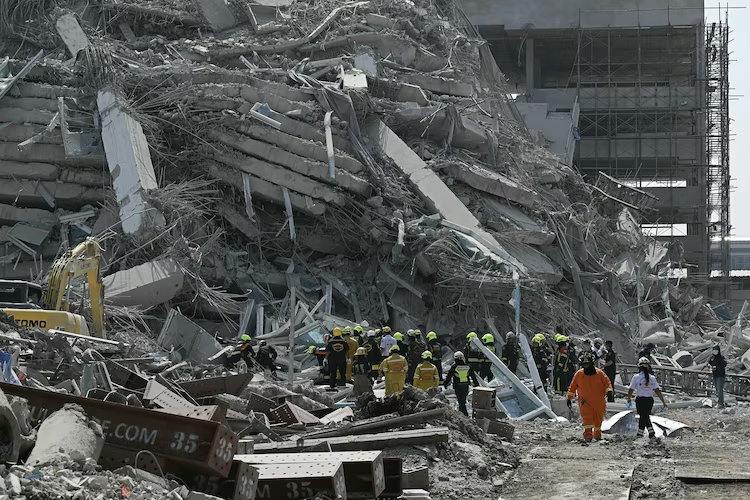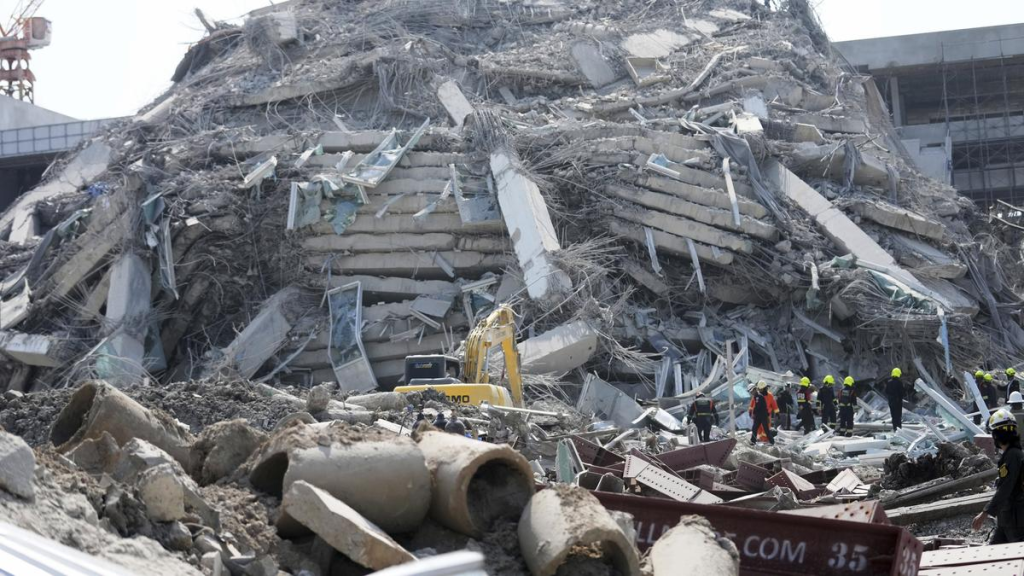A powerful 7.7 magnitude earthquake struck Southeast Asia on Friday, sending shockwaves from Myanmar to Thailand. The quake, with its epicenter near Mandalay, Myanmar, has caused widespread destruction and panic. In Bangkok, the tremors led to the collapse of a high-rise building under construction, triggering one of the most significant earthquake in Thailand events in recent years.
Earthquake in Thailand Causing Panic in Bangkok
The tremors from the 7.7 magnitude earthquake in Thailand were strongly felt in it’s capital, Bangkok—a rare Bangkok earthquake that has stunned both residents and visitors. Around 1:30 p.m. local time, alarms rang out across high-rise buildings as the shaking intensified. In one dramatic incident near Chatuchak Market, a 30-story government office building under construction collapsed, causing a massive dust cloud and sending dozens of construction workers into a desperate scramble for safety.

Just experienced a 7.7 strength #earthquake in #Bangkok for close to 3 minutes. Its epicenter was Mandalay, Myanmar, over 1200 kms from here.
— Joseph Çiprut (@mindthrust) March 28, 2025
Despite the distance it swayed buildings; caused cracks, forced evacuations and rooftop pools cascaded much water to down below. Scary! pic.twitter.com/iIeV7WQWN6
According to Thailand’s National Institute of Emergency Medicine (NIEM), approximately 320 workers were on the site when the building fell. Initial reports confirm at least three fatalities, with 70 workers reported missing, including 20 trapped in an elevator shaft. Eyewitness accounts describe frantic scenes: panicked crowds streaming into the streets and emergency services rushing to the scene amid gridlocked traffic. This earthquake today in Thailand has led authorities to declare Bangkok a disaster area and suspend key transit systems, including both the BTS (elevated train) and the MRT (underground subway).
Devastation in Myanmar
The earthquake, centered near Mandalay, Myanmar’s second-largest city, has left a trail of devastation. Reports indicate that multiple structures—including historic sites and government buildings—suffered severe damage. Myanmar’s ruling junta, which has been grappling with an ongoing civil conflict, declared a state of emergency in six regions including Sagaing, Mandalay, Magway, northeastern Shan State, Naypyidaw, and Bago. This decisive move is aimed at streamlining rescue operations and securing humanitarian aid for the thousands of affected residents.
Eyewitnesses in Mandalay described scenes of collapsed buildings and chaotic streets as residents fled their homes. The structural failures extend to significant landmarks such as parts of the former royal palace and local monasteries, amplifying the cultural and historical loss. With limited access to reliable data due to tight state controls, the full extent of the damage in Myanmar remains unclear. Nonetheless, emergency responders are urging for international assistance to support the overwhelmed local services.
Aftershocks and Continued Concerns
In the wake of the main 7.7 magnitude event, a strong aftershock measuring 6.4 on the scale rattled the region, adding to the chaos and complicating rescue operations. These successive tremors have heightened the fear of further structural failures in Bangkok and other urban centers across Thailand. Residents have been advised to remain outdoors and avoid re-entering buildings until engineers can confirm their safety.
Local officials, including Thai Prime Minister Paetongtarn Shinawatra, have convened emergency meetings and mobilized additional rescue teams. The government is now focusing on locating survivors trapped in the rubble and assessing the damage across the city. The ongoing uncertainty has prompted urgent calls for both domestic and international humanitarian aid to support the strained emergency services.
International Response
As rescue efforts continue, the international community is beginning to respond. Prime Minister Narendra Modi of India expressed his country’s readiness to offer “all possible assistance” to both Myanmar and Thailand. Similarly, European Union President Ursula von der Leyen announced that the EU is prepared to provide support in the aftermath of the disaster.
The regional implications of this earthquake are significant. In addition to Myanmar and Thailand, tremors were felt in neighboring countries such as China, India, Bangladesh, Vietnam, and Laos—highlighting the far-reaching impact of this natural disaster. This event is now being closely monitored by seismologists and disaster response teams, as experts warn that this 7.7 magnitude earthquake could have long-term economic and social repercussions for the entire region.
A Call for Unity and Urgent Aid
With thousands of lives disrupted and critical infrastructure damaged, the twin crises in Myanmar and Bangkok underscore the urgent need for coordinated disaster response. As emergency crews work tirelessly amid aftershocks and falling debris, local authorities and international partners are uniting to deliver essential aid, support recovery efforts, and mitigate the risk of further tragedies.
Residents are urged to stay informed through official channels and heed evacuation orders. The coming days will be critical in determining the full impact of the earthquake and the speed of recovery. This catastrophic event serves as a stark reminder of the unpredictable power of nature—and the essential importance of preparedness and rapid response in the face of such disasters.


